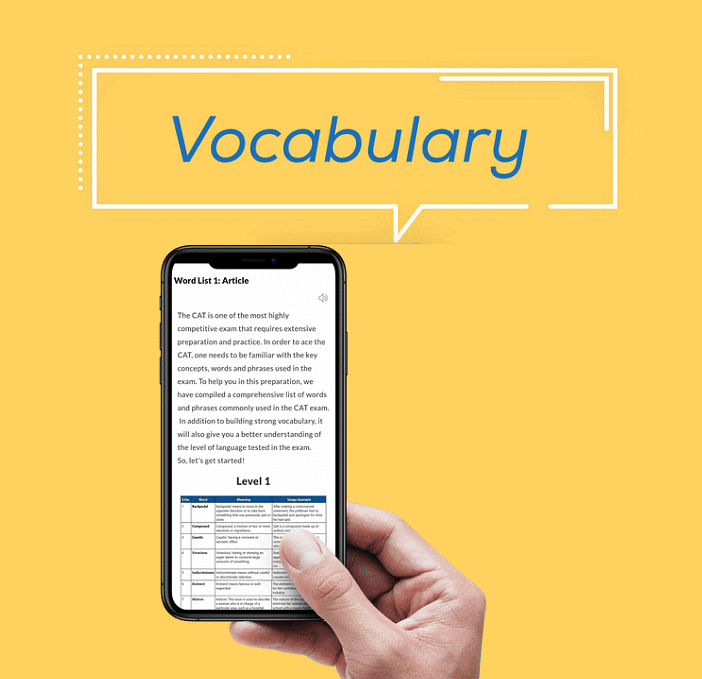Knowing the right words can make a world of difference. It’s no surprise that CAT VARC (Verbal Ability and Reading Comprehension) has become increasingly significant for aspirants of various management entrance exams.
 Having a strong vocabulary is the primary key to ace the VARC section of the CAT Exam.
Having a strong vocabulary is the primary key to ace the VARC section of the CAT Exam.
- It not only helps you to understand the questions better but also enables you to express your thoughts in a more crisp and concise manner.
- However, building a robust vocabulary requires a lot of hard work and dedication.
- In this article, we will discuss some tips and strategies to help you improve your vocabulary and ace the VARC section of the CAT exam.
What is CAT VARC?

VARC stands for Verbal Ability and Reading Comprehension.
- In the CAT Exam, there are two sections, one is Quantitative Ability and the other is Verbal Ability and Reading Comprehension.
- This section is of 34% percent of the total marks.
There are total 24 questions in this section and each question is of 3 mark. There is negative marking for this section.
- This section is as important as the Quantitative Ability section. So, building a robust vocabulary is very important in the VARC section.
- Similar to the Quantitative Ability section, the CAT VARC section is designed to test your problem-solving and critical thinking skills, along with your verbal and analytical abilities.
- The section tests the candidates’ ability to comprehend and interpret written material, identify main ideas, draw inferences, and make deductions.
- VARC is also responsible for assessing the candidate’s ability to understand the underlying meanings of words, recognize and use appropriate grammar, and form meaningful sentences.
What are the benefits of having a good vocabulary?

1. Improved Verbal Ability Section
- Having a good vocabulary helps to express ideas clearly and accurately.
- It enables to understand complex written passages and increases the chances of comprehending the nuances of a topic.
- This helps to answer questions better in VARC Section.
2. Improves Reading Comprehension
- With a good vocabulary, one can read more efficiently as words are understood quickly.
- This leads to better comprehension of the text and helps to skim and scan the text more quickly and accurately.
3. Improved Speed
- Having a good vocabulary helps to answer questions quickly as the questions are understood more quickly due to a larger understanding of words.
- This helps to save time in the VARC section.
4. Helps to Avoid Ambiguity

- Having a good vocabulary helps to avoid any ambiguity in the answers as the words used are more precise and accurate.
- This leads to fewer mistakes in the VARC section.
5. Improves Writing Ability
- A good vocabulary helps to write with clarity and precision.
- This helps to express ideas more effectively and can help to improve scores in the VARC Section.
6. Increased Confidence
Having a good vocabulary boosts confidence, as the words used are precise and accurate. This helps to answer questions confidently and effectively
Tips for improving your vocabulary for CAT VARC
Having a strong vocabulary is important for the VARC section of the Common Admission Test (CAT) because it tests your understanding of written English.
A good vocabulary can help you understand the meaning of the questions and the passages in the section, which can help you answer the questions correctly and improve your score on the exam.
1. Read more
- Reading is perhaps the best and easiest way to improve your vocabulary.
- Reading a variety of different types of literature will help you to expand your vocabulary and increase your understanding of words.
2. Refer to our E-library of CAT
- Our E-library contains many vocabulary building lists which can be used to not only help you understand the meaning of new words but also help you remember them.
- It gives all the lists related to High-Frequency Words, Mediu Frequency words, Low Frequency Words, Root Words, Prefix and Suffix, and Foreign Word Lists
3. Use flashcards
- Flashcards are another great way to help you remember new words.
- You can write word on one side of the flashcard and its meaning and usage on the other side.
- Flashcards are an effective way to learn new words for the CAT Exam and can help you prepare for the exam and get a better score.
4. Learning etymology or roots of the word

- This is a good way to remember the meaning of words. Most words in English have a Latin or Greek root.
- Etymology helps us learn about how the word originated and reached its current form. It will tell you about its relations with other words.
- This helps build a story and a story is always easier to remember than facts.
5. Learn 5 new words every day.
- Every day because learning 5 words is a small target but if you do it every day, you will have 150 new words by the end of the month.
- By the end of 6 months, you will have 900 words.
- Learning this way keeps you consistent. You will work a little every day.
- Consistency in the everyday effort is much more efficient than working hard but just for one day or a few days and then forgetting about vocabulary.
6. Keep a vocab notebook.

- Keeping a notebook just for vocabulary will help you immensely.
- You can keep revising when you have free time.
- The act of writing it down also registers the word in your memory.
- Keeping a notebook for vocabulary for CAT will also help you track your vocab progress.
- This progress will hold you accountable, which will motivate you to learn even more vocab.
Strategies for building your vocabulary

1. Use context clues
- If you come across a word that you don’t know, try to use context clues to determine what it means.
- Context clues are pieces of information within a sentence or passage that can help you figure out the meaning of an unfamiliar word.

- For example, if you come across the phrase “The man was chagrined by his mistake”, you can use the context clues of “disappointed” and “mistake” to figure out that “chagrined” likely means “upset” or “disappointed”.
- Context clues can come in the form of descriptions, examples, synonyms, or antonyms.
- By looking at the words around the unfamiliar word, you can often figure out what it means without having to look it up in the dictionary.
2. Associate words with Images
- Using visual methods to help you remember new words is quite common. You can use images to help you associate new words with their meanings.
- By creating a mental image, you are engaging more of your senses and therefore increasing the chances that you will remember the word and its meaning.
- You can also link the word to an action, such as a person picking an apple from a tree, to help you remember the word. This type of visual association can help you remember words and their meanings more effectively.
3. Build your vocabulary from all areas

- You can’t build a strong vocabulary by only reading about one type of subject. You need to expand your vocabulary from all subjects.
- This means reading books, magazines, newspapers and articles from different areas.
- You can increase your understanding of different words and their meanings. by making a conscious effort to use new words in your conversations and writing.
- Writing down the new words you come across and then looking up their meanings is also a great way to commit them to memory. Lastly, you can use flashcards and other memorization techniques to learn and retain new words.
4. Using mnemonic devices.
- Mnemonic devices can be used to help remember information, such as using catchy rhymes or acronyms.
- For example, to remember the colors of the rainbow (red, orange, yellow, green, blue, indigo, violet), you could use the mnemonic device “Roy G. Biv” (the letters standing for the colors in the order they appear in the rainbow).
- You could also come up with a catchy phrase such as “Red Orange Yellow Green Blue Indigo Violet, ROYGBIV!”
- Mnemonic devices can be used to remember all sorts of information, such as a list of items, facts, dates, or equations.
- They can also be used to help with spelling or pronunciation of unfamiliar words.
5. Practice translation and substitution
- Translation and substitution are two different ways you can use to expand your vocabulary.
- Translation and substitution are two different ways you can use to expand your vocabulary.
- Translation involves replacing one word with its equivalent in another language.
- Substitution involves replacing a word with one that has a similar meaning.
- For example, if you want to replace the word “large” with a word that has a similar meaning, you can use the word “big”.
- Both of these techniques are useful for learning new words, as well as helping you to understand the meaning of words in another language.
- In addition, using these techniques can help you to think more critically and creatively when communicating in a new language.
6. Use a Thesaurus

- This can be a great way to expand your vocabulary, especially when you are trying to find more complex words to describe concepts or ideas.
- This can be a great way to expand your vocabulary, especially when you are trying to find more complex words to describe concepts or ideas.
- By using a thesaurus, you can look up words that have similar meanings and find the most appropriate one for your sentence or document.
- Additionally, a thesaurus can help you to find synonyms that you may not have considered before. This can help you to make your writing more varied and dynamic.
7. Create a reading plan
- If you want to build your vocabulary, you have to read more.
- You have to make time for reading in your schedule.
- A reading plan can help you with that.
- You can use a reading plan to read different types of literature as well.
- You can follow the 120 Day plan prepared by EduRev experts for a study plan.
8. Make vocabulary building a habit

- You have to make vocabulary building a habit if you want to improve your vocabulary on a regular basis.
- Try to use the words you have learned in your everyday life. This will help you to cement the words in your memory and make them part of your daily vocabulary.
- Start by setting aside a few minutes each day for learning new words. This could be done by reading a book or magazine, listening to a podcast, or using a language learning app. You could also try writing down new words you come across in your daily life and looking up their meanings.
How to practice and evaluate your vocabulary?

- The first step is to identify and familiarize yourself with the root words, prefixes, and suffixes associated with a given topic.
- Once you have a strong foundation, you can use practice tests to evaluate and build your vocabulary.
- You can find resources on EduRev to practice vocabulary building, like crosswords and word quizzes
- Of course, reading is one of the best ways to learn and improve your vocabulary. Reading books, newspapers, and magazines can all help to expand your understanding of language, as well as provide context for new words.
- With a combination of practice tests and reading, you can be sure your vocabulary is up to par.
- Along with above steps, read the news more often.
Reading the news can be a great way to expand your vocabulary. It’s also a great way to keep up with current events and developments.
The EduRev E- library is a comprehensive digital library of word lists of level 1, 2, and 3. More over you get a list of word roots, prefix & suffix and many more. It also lists books of different genres.
Also Read:
Common mistakes to avoid while developing vocabulary
1. Not using context clues
You have to use context clues to understand the meanings of new words. You can’t just look up the meanings of new words in the dictionary.
2. Relying solely on memorization
Memorizing words is not enough, you need to understand the meaning of each word and learn to use them in context.
Memorizing the definitions of words will not help in developing vocabulary. It is important to understand how words are used in different contexts.
3. Not using thesaurus
You can use thesaurus to expand your vocabulary. It can also help you to understand words better by providing definitions, synonyms and antonyms.
4. Not creating a vocabulary list
You have to make a vocabulary list when you come across a new word. You have to add it to the list.
5. Not reading consistently
Developing a strong vocabulary takes time and practice. It is important to set aside time each day to review and practice new words.
How to use your vocabulary to answer questions?
- In the CAT Exam, there is a passage of around 600-700 words. The passage is followed by 4 questions. The passage can be about any topic. It can be from any field like technology, history, economics, etc. The passage can be from any source like a magazine, newspaper, article, textbook, etc.
- The passage is for around 8 minutes. So if you are habitual of adapting to new genres of areas while reading, you will overcome the shock factor in the exam if a passage comes from an area which you are not aware of.
- Try to find connections between the keywords in the question that will help you identify the words you need.
- Review the words you learned in your preparation course. Make sure you fully understand the definitions of these words and how to use them in context.
- Then, when you're reading the passages for the VARC Section, pay attention to the context and any unfamiliar words.
- Once you know what the words mean, you'll be able to answer the associated questions more easily.
- Finally, keep a list of words you don't know, and make sure to review them regularly.
With practice and dedication, you'll be able to use your vocabulary to boost your scores in the CAT Exam.
Frequently asked questions (FAQs)
Q. What is the VARC section in CAT?
Frequently asked questions (FAQs)
VARC stands for Verbal Ability and Reading Comprehension. It is one of the three sections in the Common Admission Test (CAT). The VARC section is designed to measure a candidate’s ability to comprehend, analyze, and interpret written material. The questions in this section range from basic reading comprehension to complex verbal reasoning and analytical skills.
Q. How to Improve VARC for CAT?
1. Read Regularly: Establish a habit of reading regularly and become more aware of the English language and literature.
2. Expand Vocabulary and Improve Grammar.
3. Work on a Strategy: The reading comprehension section requires a strategy to go over the text and answer the questions as quickly as possible.4. Solve Regular Mocks: Keep Practising. It will help you build a strategy for the VARC section.
EduRev has an extensive collection of Verbal Ability and Reading Comprehension (VARC) questions with solutions. This will help you understand the fundamentals and practice your skills. You can also attempt mock tests and analyze your performance to identify areas for improvement.
Q. What are the best books to Prepare VARC for CAT?
To help candidates prepare for VARC for CAT, we have listed a few books that can be used for guidance alongside mock papers and previous years' papers.
- Word Power Made Easy- Norman Lewis
- How to Prepare for Verbal Ability and Reading Comprehension for the CAT- Arun Sharma and Meenakshi Upadhyay
- Mastering the Verbal Ability for CAT- Ajay Singh
- A Modern Approach to Verbal & Non-Verbal Reasoning- R.S. Aggarwal
Q. Is it easy to score well in Quant but tough to score well in VARC?
CAT is a tough exam. All the three sections of CAT are usually of high difficulty level. However, many candidates find QA questions easier to solve as they are formula and calculation based, whereas VARC has RC passages which are inference based and related parajumble questions could be confusing.EduRev offers you the best online preparation material for CAT that provides tailored study plans and mock tests to help you ace the exam. Start your journey towards success with EduRev now!
Q. What is the sequence of CAT question paper? Can I choose the order of sections for solving question?
The sequence of CAT question paper is - Section 1: VARC, Section 2: DILR and Section 3: Quantitative Aptitude. Candidates have to solve the question paper in the same sequence. They cannot switch from one section to another.
Q. What is the sectional breakup of CAT question paper?
VARC sections has 24 questions, QA has 22 questions and DILR section has 20 questions. Each question carries three marks for correct answer and negative marking of minus one for wrong answer.
Edurev offers comprehensive learning material for CAT exam preparation. It covers all the topics from VARC, QA and DILR sections and provides detailed solutions to each question. It also provides practice tests and mock tests to help students understand their weak and strong areas and work on them.
FAQs on How to Improve Your Vocabulary for CAT VARC: Tips and Strategies To Ace The Exam
| 1. What is CAT VARC? |  |
| 2. What are the benefits of having a good vocabulary? |  |
| 3. Tips for improving your vocabulary for CAT VARC? |  |
| 4. Strategies for building your vocabulary? |  |
| 5. How to practice and evaluate your vocabulary? |  |















